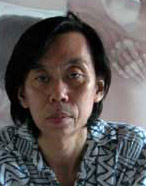 |
||
|---|---|---|
| CP Foundation | About CP Biennale | 2003 | 2005 | Contact Us | >||
           
|
||
|
In his latest development Chusin managed to combine two techniques, which were albeit being in the "family" of realistic portrayal, had nevertheless two different orders. The success of this effort could be seen when these two orders that were merged resulted in another order. In his best nude paintings done between 2001-2002, Diagonal (2001), Swing (2001), White Contour (2001) and Space (2002), a sensitivity which can usually be felt when seeing lines of model drawing, appeared in these paintings. The sensitivity can especially be seen in the encounter of the white lines of body's contour and the white color of the background. The encounter presents a tension felt on illusory lines of the body's contour, which exist because the flat white color meets the textured white color. In his paintings shown in this biennale, it can easily be seen the usage of colors that tend to show tensions is a betrayal of realistic painting of human bodies. The effect of lights that is generally used to construct three-dimensional illusion in this painting shows a sense of transparency and makes this painting not only unrealistic, but also unimaginable in reality. That painting is actually a poetic theatrical expression. The bodies are portrayed in various positions and gestures, creating a rhythm. The white space and light, meanwhile, strengthen the poetic impression. The painting tend to be political since it invites various public opinions and interpretation on the positions of nudes, space, and wide aspects of the problems regarding men and women. As we view the painting, we feel the tension created by the existence of the problems and the beauty of the painting. Jim Supangkat, Hardiman Born on March 4, 1949 in Bandung. SELECTED SOLO EXHIBITIONS SELECTED GROUP EXHIBITIONS |
||
|
CP Foundation | About CP Biennale | 2003 | 2005 | Contact Us
Jl. Suryopranoto 67A, Jakarta 10160, Indonesia. ph. +62.21.3448126, 3853206 | fax. +62.21.3853203, 3853208 info@cp-foundation.org |
||
 During his creative journey, Chusin's works have once displayed expressive, decorative, and formalistic tendencies. All these tendencies have put his artistic idioms in an intricate position. Chusin, however, thinks of such intricacy as a passion. Chusin Setiadikara, who had once learned painting from the senior painter Barli Sasmitawinata in the Rangga Gempol Studio in Bandung, then explored the many possibilities offered in the idioms of realistic portrayals. He believes that realistic portrayal technique has not come to an end.
The realistic portrayal he concerns cannot be linked with obsession for a resemblance between painting and reality, which is the premise taken up by the realistic portrayal in the development of art. He doesn't use resemblance as a basic concept. Chusin for example used photographs in his creative process but not to be copied. He uses them for observation.
During his creative journey, Chusin's works have once displayed expressive, decorative, and formalistic tendencies. All these tendencies have put his artistic idioms in an intricate position. Chusin, however, thinks of such intricacy as a passion. Chusin Setiadikara, who had once learned painting from the senior painter Barli Sasmitawinata in the Rangga Gempol Studio in Bandung, then explored the many possibilities offered in the idioms of realistic portrayals. He believes that realistic portrayal technique has not come to an end.
The realistic portrayal he concerns cannot be linked with obsession for a resemblance between painting and reality, which is the premise taken up by the realistic portrayal in the development of art. He doesn't use resemblance as a basic concept. Chusin for example used photographs in his creative process but not to be copied. He uses them for observation.